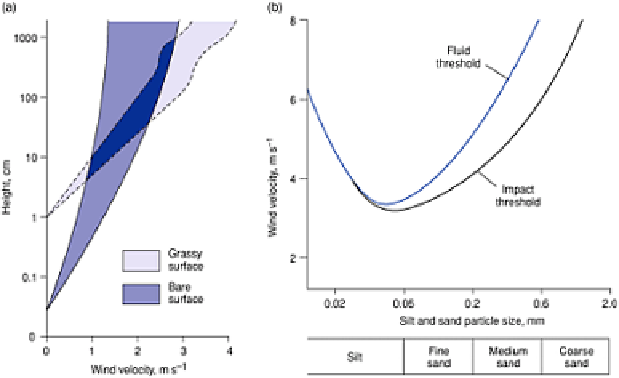Environmental Engineering Reference
In-Depth Information
Wind first winnows or sifts clay, silt and sand grains from coarser particles, too large to
be deflated and therefore left behind as
lag deposits
. As
effective wind velocity
increases,
it imposes a surface shear stress or drag on exposed particles which may at first roll or
creep without becoming airborne. Shear stress increases exponentially with wind velocity
from 2 N m
−2
at 1·3 m s
−1
to 100 N m
−2
at 13 m s
−1
. This establishes general motion,
which interacts with air flow in the development of bed forms, discussed later.
Ballistic impact
or collisions between particles, as they begin to move, sets a broader
field of particles sliding or rolling in a process known as
reptation
. Larger sand grains
may continue to move by such means. Fine particles become entrained in the air stream
when turbulent lift and shear stress exceed normal stress and friction. Wind velocity
increases rapidly above the land surface as friction falls, reducing pressure above the
particles (Figure 1). This creates a
Bernouilli effect
which draws fine particles upwards
into the flow. Entrainment may also occur by saltation as ballistic impacts from
descending particles kick others into the air. Larger sand grains have low, short
trajectories and move mostly by saltation, whereas, once airborne, turbulence may
support finer grains up to 200 µm in suspension indefinitely.
The sequence from creep, reptation, saltation to suspension occurs with increasing
wind velocity or decreasing particle size. Average grain size in sand seas lies between
100 µm and 1 mm, with a modal size approximately 300 µm. Entrainment and ballistic
thresholds for medium and coarse sand (over 200 µm and 600 µm to 2 mm respectively)
are 5·0 and 4·2 m s
−1
and 8·0 and 6·0 m s
−1
(with 5·5 and 4·5 m s
−1
for the modal size).
Deflation is the prerequisite for all other processes in the aeolian environment,
including abrasion and sandblast, the excavation of
deflation hollows
and creation of
mobile bed forms. A special case can also be made for particulate
injection
by volcanic
eruption and sea spray, adding ash, tephra and fine coastal materials to the atmosphere.
Although not part of the aeolian mainstream, they may occur in quantities capable of
geomorphic and stratigraphic significance.
Figure 1
Comparative threshold conditions for deflation: (a) wind





